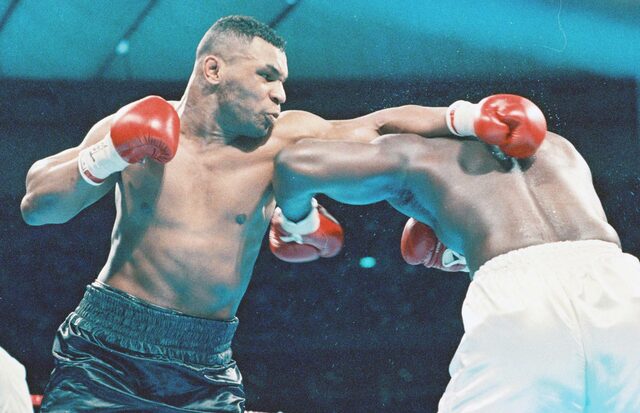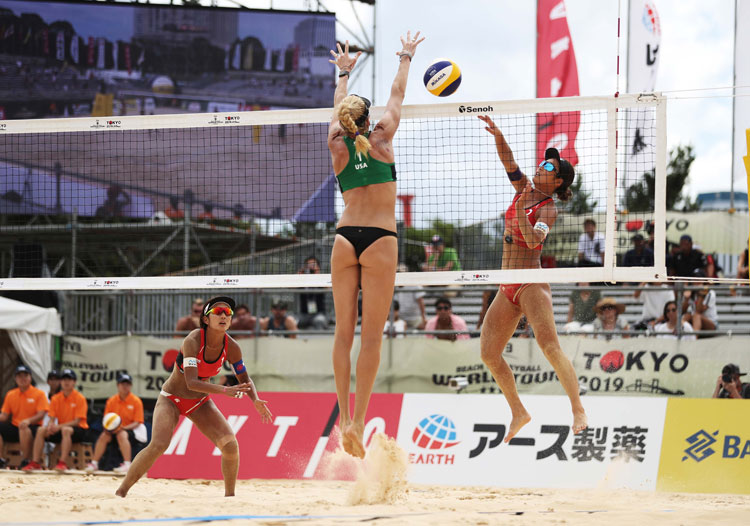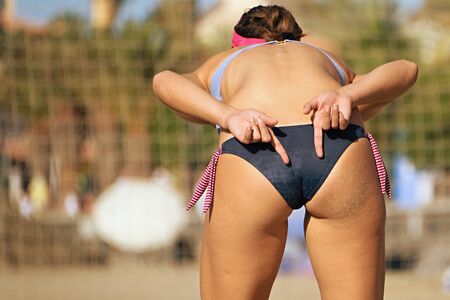
In beach volleyball, the serve plays a vital role in leading the game.
The serve is used not only to start the match, but also as a means of putting pressure on the opposing team.
However, in order to serve effectively, it is necessary to accurately understand the serve rules specific to beach volleyball and practice them appropriately.
In this article, we will explain in detail the basics of beach volleyball serve rules, how to use the serve tactically, and even practice methods to improve your serve technique.
Learn the finer points of serve rules and turn your serve into an even more powerful weapon in the game.
From now on, we will comprehensively learn all the information regarding the serve rules of beach volleyball.
目次
Introduction: The importance of the beach volleyball serve in the game
In beach volleyball, the serve is more than just a way to start the game.
A powerful serve is an important tactic to put pressure on the opposing team and can create scoring opportunities.
Below we detail why serves are so important in the game.
Build pressure with serve
The serve is the first opportunity to apply direct pressure on the opposing team.
A powerful and accurate serve can make it difficult for your opponent to receive and disrupt the flow of passes, setups, and attacks.
In this way, the serve disrupts the opponent’s tactics and creates opportunities that lead to points.
Serve as a source of points
In beach volleyball, it is very valuable to get points (aces) directly from the serve.
In particular, serving where your opponent doesn’t expect it or where they feel the weakest increases your chances of getting an ace.
Additionally, forcing the opposing team to make mistakes with serves can directly lead to points.
Tactics using serve
The serve is also used as a tactical tool. There are various tactics that can be considered, such as serving to target the opponent’s weak point or serving with a breaking ball to change the flow of the game.
Serve selection and execution are essential to controlling the flow of the match and creating advantageous situations for your team.
Mental effects of serving
Powerful serves and consecutive successful serves have a psychological impact on the opposing team.
On the other hand, your own team can gain confidence by serving, which can increase the motivation of the entire team.
This kind of mental advantage can have a direct impact on winning or losing a match.
The importance of the serve in beach volleyball is clear from these factors.
By honing your serve technique and using it tactically, you can establish an advantage in the match and get closer to victory.
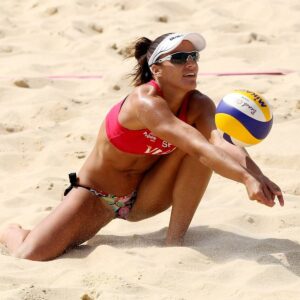
Beach volleyball serve rules basics
The beach volleyball serve provides a great opportunity to start the game and score, but requires an understanding of precise rules and procedures.
Here, we will explain in detail the basic rules and procedures for serving in beach volleyball, the position when serving, and how to handle the ball.
Compliance with these rules will ensure fair and smooth gameplay.
Basic rules and procedures for serving
- Start of serve : The serve must be made within 5 seconds after the referee’s whistle. The serving team must make the ball visible to the opposing team and the referee before hitting it.
- Change of serve : The scoring system is a rally point system, and the right to serve goes to the team that wins points. When the right to serve changes, the players will also rotate.
- Foot Fault : When serving, a player must not step on the end line or its extension. If a foot fault occurs, the right to serve passes to the opposing team.
Position and ball handling when serving
- Serving Position : The serving player must be positioned at the back of the court, behind the end line. The serve may be made from anywhere on the court, but may not go beyond the end line.
- Ball Handling : When serving, the ball must be hit directly with the hand or arm. At the moment you hit the ball, the ball must not be touching any other object.
- Types of serves : Different types of serves are allowed in beach volleyball, including overhand serves, underhand serves, and jump serves. Regardless of the type of serve, the correct procedure must be followed.
Understanding and applying beach volleyball serve rules is important to keep the game fair and to take advantage of tactical advantages.
Mastering the basic rules and procedures of serving, proper positioning and ball handling will help you achieve greater success in the game.

Serve types and tactics
The serve in beach volleyball is a tactical element that greatly influences the flow of the match.
Each type of serve has its own characteristics, and by using them tactically, it is possible to put pressure on the opposing team and increase scoring opportunities.
Here, we will delve into effective types of serves, their characteristics, and tactical approaches using serves.
Effective types of serves and their characteristics
- Floater serve : A serve where the ball is hit without any rotation, creating an unpredictable trajectory that is easily affected by the wind. It is a difficult serve for the receiving side, and it is easy to get an ace.
- Topspin serve : A serve in which the ball is hit with a strong upward rotation, and its speed is fast and its landing point is difficult to predict. It is effective in breaking down the opponent’s reception.
- Jump serve : A serve that hits the ball like a powerful spike while jumping, and is attractive for its high attack power. However, it is easy to make mistakes, so risk management is important.
Tactical approach with serve
- Target your opponent’s weak points : By serving to a player on the opposing team whose reception is unstable, you can increase your chances of getting an ace or break up your opponent’s setup.
- Vary your serve : Instead of repeating the same type of serve over and over again, you can keep putting pressure on your opponent by changing your serve, such as a floater serve or topspin serve, depending on the situation.
- Control the rhythm of the game with your serve : Earning consecutive points with your serve will motivate your team and disrupt the rhythm of the opposing team. By actively aiming for an aggressive serve, you can take control of the game.
The serve is an important tactical tool in beach volleyball.
By understanding the types of serves and adopting a tactical approach that takes advantage of the characteristics of each serve, you will be able to create an advantageous development in the match.

Serve Rules FAQ
In beach volleyball, violating the rules regarding serves can affect the flow of the game.
It is important for players to know details about the violations and penalties that can occur during a serve, as well as the serve substitution rules.
Below, we’ll answer some frequently asked questions about these serve rules.
Violations and penalties during serve
- Foot Fault : Occurs when a player steps on or extends beyond the end line while serving. If this violation occurs, the right to serve immediately passes to the opposing team.
- Delay : The serve must be executed within 5 seconds after the referee’s whistle. If a serve is served after this time, it will be considered a delay and the right to serve will be transferred to the opposing team.
- Illegal Serving Action : Hiding the ball or hitting it in an illegal manner when serving is a violation. If you do not follow the correct serving action, the right to serve will also be transferred to your opponent.
Details of serve substitution rules
Beach volleyball uses a rally point system. As a result, the following serve substitution rules will apply:
- Change of serving rights : The serving rights will be changed every time a point is decided. If your team scores, they continue to hold the right to serve and exchange positions between players.
- Swapping positions : When the right to serve is maintained, players exchange front and back positions with their teammates, as beach volleyball is played in two-person format. This substitution only takes place when a team has earned a point.
- Loss of Serving Rights : If a team makes a serving error or concedes a point to the opposing team, the serving right passes to the opposing team.
Knowledge of these serve rules is essential when playing beach volleyball.
By understanding and applying the rules accurately, you can avoid unnecessary violations during the game and have a smoother and more enjoyable match.
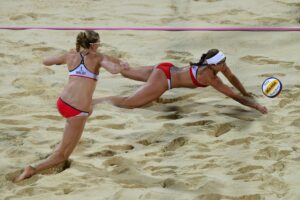
Improving serve technique
In beach volleyball, the serve is an important element that determines the flow of the match.
Improving the accuracy and power of your serve is essential to putting pressure on the opposing team and creating advantageous situations for your team.
Here, we will introduce training methods to improve serve accuracy and practice menus to improve serve power.
Training methods to improve serve accuracy
- Target practice : Set up a target on the court and serve to the target. This allows you to improve the direction and accuracy of your serve. Place targets in different places on the court and practice serving from various angles.
- Repetitive practice : By repeating the serve motion repeatedly, your body will memorize the movement. Serving with consistent form is the key to improving accuracy. When practicing, focus on correct form and repeat the same movements.
- Video analysis : Capture and analyze video of your serving action to find areas to improve your form. In particular, check the areas that need fine-tuning, such as the rhythm of your run-up and how you hit the ball.
- Jump Training : The power of your serve comes from your jumping power. Do exercises to increase your lower body strength, such as squat jumps and box jumps. These exercises will help you improve your jump height and power.
- Core Training : Core strength is important when serving. Include core-strengthening exercises like planks and Russian twists. This gives you more stability and power when serving.
- Strengthen your arm swing : To increase the power of your serve, you also need to strengthen your arm swing. Practicing arm swings using light dumbbells and training with elastic bands are effective.
Improving your serve technique is achieved through learning accurate form, balancing power and precision, and continuous practice.
By practicing these training methods and practice menus, your serve will become a more effective weapon.

Summary: Master the serve rules of beach volleyball and use them in your matches
In beach volleyball, the serve is a decisive element that can influence the flow of the match.
A powerful and accurate serve can put great pressure on the opposing team and at the same time create an advantageous development for your own team.
Accurately understanding the serve rules and utilizing them appropriately are important steps to success in beach volleyball.
Through this guide, you’ve learned about the basic rules of serving, types of serves and tactical approaches, rule violations and penalties, and how to improve your serving technique.
Below are the main points to master the beach volleyball serve rules and apply them in your matches.
Understanding serve rules
- The serve must be executed within 5 seconds after the referee’s whistle. Watch out for rule violations such as foot faults and delays.
- Make sure you understand the serve change rules and don’t forget to swap positions between players when winning points.
tactical approach
- Use different types of serves (floater serve, topspin serve, jump serve, etc.) and develop a strategy to target your opponent’s weak points.
- By changing your serve, confuse the opposing team and increase your team’s chances of scoring.
Improvement of technology
- To improve the accuracy and power of your serves, be proactive about target practice, core training, and jump training.
- Improve your serving technique through regular training and repeated practice.
If you can master the serve rules of beach volleyball and utilize these points in your matches, you will be able to greatly contribute to improving your game control, expanding your scoring opportunities, and ultimately winning the match.
The serve is one of the basics of beach volleyball, but it is also one of the most influential elements in the match.
Therefore, it is important to maintain constant attention and practice on your serve and to constantly update your skill set.
